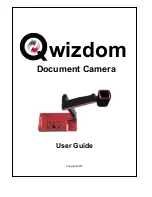
VIS-CAM Systems
96
Appendix I
please use “interpacket delay” register.
“
One
”:
Wait for a single Ethernet or HW TTL trigger. Snapshot a single image as
soon as the next trigger is received.
“
All
”:
Continuously wait for Ethernet or HW TTL trigger. Display images as soon
as the trigger is received. Click “Freeze” to stop this operation.
“Last”:
Same as “All”, except that the software displays the last image captured
as soon as “Last” button is clicked.
NOTE: Flash is disabled in Live mode.
UDP image is sent to the single client who sends the last command (Snap, Live, One, All, Last). No duplicated
image is sent to other clients. However, please note that while this TEST PORT is activated, the camera does
not send images to the FTP server or JAI ImageServer, and therefore, the normal transaction halts.
13.3
3. TCP image (CONTROL PORT)
If “Freeze” button is selected, the camera stops sending UDP images (TEST PORT), and therefore, the camera
sends TCP images via CONTROL PORT, or FTP images to FTP server.
If you want to receive the TCP image to the ENSetup software, make sure to select “Use TCP/IP” under View
menu. Select “Freeze” button.
Whenever the camera receives a next trigger, whether this is Ethernet trigger or TTL trigger, or whether this is
from Lane controller or from ENSetup software (“Eth Trigger” or “Rep. Trigger” button), the camera captures
the image and sends to all clients, which are both lane controller and ENSetup software.
Same image is sent to FTP server as well.
If you wish to monitor the image of the camera outside of camera’s subnet, the router may block the UDP
image. Using this TCP image, the ENSetup software can receive image even if your host PC is outside of the
router or camera’s subnet.
Again, the side effect is that the lane controller receives the same copy messages from or for the ENSetup
software (command, image, etc.) In other words, the lane controller receives big chunk of image data, even if
it is not expected. This is a copy of TCP image data that are sent to the ENSetup software, and the lane
controller can simply trash such image data, as the same image is sent to FTP server any way. (FTP image is
never duplicated, no matter how many clients are connected to the camera.)
Summary of Contents for VIS-CAM System
Page 1: ...VIS CAM System Vehicle Imaging Subsystem Document Version 10436 Document P N E...
Page 2: ......
Page 12: ...VIS CAM Systems xii List of Tables...
Page 20: ...VIS CAM Systems 8 Preparing for Installation Figure 5 VIS 300 U S Camera options chart...
Page 21: ...Preparing for Installation 9 VIS CAM Systems Figure 6 VIS 350 U S Camera options chart...
Page 22: ...VIS CAM Systems 10 Preparing for Installation Figure 7 VIS 400 U S Camera options chart...
Page 23: ...Preparing for Installation 11 VIS CAM Systems Figure 8 VIS 500 U S Camera options chart...
Page 24: ...VIS CAM Systems 12 Preparing for Installation Figure 9 VIS 300 European Camera options chart...
Page 25: ...Preparing for Installation 13 VIS CAM Systems Figure 10 VIS 350 European Camera options chart...
Page 26: ...VIS CAM Systems 14 Preparing for Installation Figure 11 VIS 400 European Camera options chart...
Page 27: ...Preparing for Installation 15 VIS CAM Systems Figure 12 VIS 500 European Camera options chart...
Page 92: ...VIS CAM Systems 80 Appendix B Figure 90 Lane controller setup...
Page 100: ...VIS CAM Systems 88 Appendix E Figure 98 Operation configuration of Serial port 1...
Page 110: ......
Page 111: ......





































